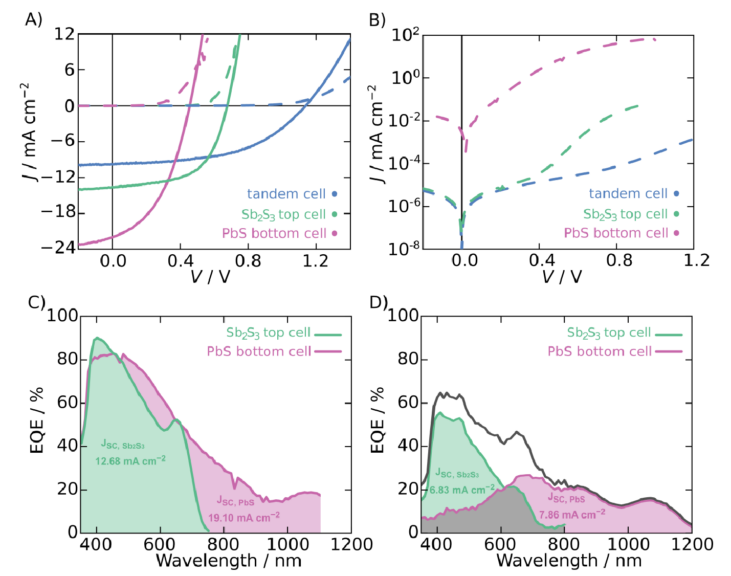Selina Kern, Gyusang Yi, Pascal Büttner, Florian Scheler, Minh-Hoa Tran, Sofia
Korenko, Katharina E. Dehm, Ivan Kundrata, Steve Albrecht, Julien Bachmann, Ryan
W. Crisp – 10.26434/chemrxiv-2023-f4k03
Multijunction solar cells show the prospect to raise the theoretical efficiency limit of single junction solar cells by minimizing transmissive losses of large bandgap and emissive losses of lower bandgap absorber solar cells. In solar cell applications, Sb2S3 is considered an attractive absorber due to its elemental abundance, stability, and high absorption coefficient in the visible range of the solar spectrum, yet with a band gap of 1.7 eV it is transmissive for near-IR and IR photons. Using it as the top cell inside a tandem solar architecture in combination with a bottom cell employing e.g., PbS quantum dots, which have an adjustable band gap suitable for absorbing longer wavelengths, is hence a promising approach to harvest the solar spectrum more effectively. In this work, these two subcells are monolithically grown and connected in series by a poly(3,4-ethylene-dioxythiophene) polystyrene sulfonate (PEDOT:PSS)−ZnO tunnel junction as the recombination layer. We explore the surface morphology of ZnO QDs resulting from different spin coating conditions, which serve as the bottom cell’s electron transport material. Furthermore, we examine the differences in photogenerated current upon varying the PbS QDs absorber layer thickness and the electrical and optical characteristics of the tandem with respect to the standalone reference cells. This tandem architecture demonstrates an extended spectral absorption into the IR with an open-circuit potential exceeding 1.1 V and a power conversion efficiency of 5.6%, projecting above the PCE of each single-junction cell.
The authors acknowledge the generous support of the STAEDTLER Foundation, which funded this work as part of the project Accelerated Innovation for a Sustainable Solar Energy Future.

Selina Kern, Gyusang Yi, Pascal Büttner, Florian Scheler, Minh-Hoa Tran, Sofia
Korenko, Katharina E. Dehm, Ivan Kundrata, Steve Albrecht, Julien Bachmann, Ryan
W. Crisp – 10.26434/chemrxiv-2023-f4k03
Multijunction solar cells show the prospect to raise the theoretical efficiency limit of single junction solar cells by minimizing transmissive losses of large bandgap and emissive losses of lower bandgap absorber solar cells. In solar cell applications, Sb2S3 is considered an attractive absorber due to its elemental abundance, stability, and high absorption coefficient in the visible range of the solar spectrum, yet with a band gap of 1.7 eV it is transmissive for near-IR and IR photons. Using it as the top cell inside a tandem solar architecture in combination with a bottom cell employing e.g., PbS quantum dots, which have an adjustable band gap suitable for absorbing longer wavelengths, is hence a promising approach to harvest the solar spectrum more effectively. In this work, these two subcells are monolithically grown and connected in series by a poly(3,4-ethylene-dioxythiophene) polystyrene sulfonate (PEDOT:PSS)−ZnO tunnel junction as the recombination layer. We explore the surface morphology of ZnO QDs resulting from different spin coating conditions, which serve as the bottom cell’s electron transport material. Furthermore, we examine the differences in photogenerated current upon varying the PbS QDs absorber layer thickness and the electrical and optical characteristics of the tandem with respect to the standalone reference cells. This tandem architecture demonstrates an extended spectral absorption into the IR with an open-circuit potential exceeding 1.1 V and a power conversion efficiency of 5.6%, projecting above the PCE of each single-junction cell.
The authors acknowledge the generous support of the STAEDTLER Foundation, which funded this work as part of the project Accelerated Innovation for a Sustainable Solar Energy Future.